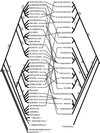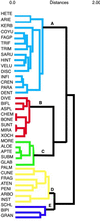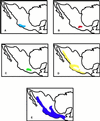Macroevolution of insect-plant associations: the relevance of host biogeography to host affiliation
- PMID: 10535973
- PMCID: PMC23020
- DOI: 10.1073/pnas.96.22.12626
Macroevolution of insect-plant associations: the relevance of host biogeography to host affiliation
Abstract
Identifying the factors that have promoted host shifts by phytophagous insects at a macroevolutionary scale is critical to understanding the associations between plants and insects. We used molecular phylogenies of the beetle genus Blepharida and its host genus Bursera to test whether these insects have been using hosts with widely overlapping ranges over evolutionary time. We also quantified the importance of host range coincidence relative to host chemistry and host phylogenetic relatedness. Overall, the evolution of host use of these insects has not been among hosts that are geographically similar. Host chemistry is the factor that best explains their macroevolutionary patterns of host use. Interestingly, one exceptional polyphagous species has shifted among geographically close chemically dissimilar plants.
Figures




References
-
- Ehrlich P R, Raven P H. Evolution. 1964;18:586–608.
-
- Berenbaum M. Evolution. 1983;37:163–179. - PubMed
-
- Becerra J X. Science. 1997;276:253–256. - PubMed
-
- Futuyma D J, McCafferty S S. Evolution. 1990;44:1885–1913. - PubMed
-
- Köpf A, Rank N E, Roininen H, Julkunen-Thtto R, Pasteels J, Tahvanainen J. Evolution. 1998;52:517–528. - PubMed
LinkOut - more resources
Full Text Sources

